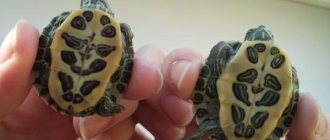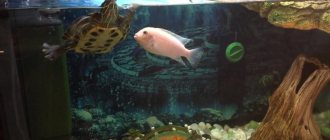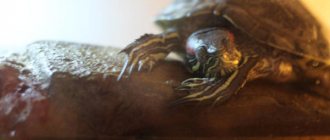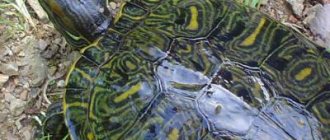How to wake up a turtle
Now we will present to your attention step-by-step instructions that will help you wake up your sleeping beauty or handsome man. So,
Temperature increase
The awakening of the turtle should be gradual
The process of awakening in the turtle’s body starts against the background of rising air temperature. This is what, in her understanding, symbolizes the arrival of the warm season. Therefore, you should gradually increase the temperature in the room in which the turtle is located. You can first place the terrarium with the turtle on the windowsill in a cool room, the next day move it to a warmer place, on the 3rd day bring it into the room and place it in its usual place. After this, it will be possible to increase the temperature in the room to 28-30 degrees Celsius within 3-4 days.
The main thing is to do this gradually, since a sudden temperature jump can lead to the death of your pet.
Water treatments
During sleep, the turtle's body became very dehydrated, so you must replenish this lack of water. Take the turtle in your arms and carefully immerse it in a warm bath, the water temperature in which should be 32-33 degrees, making sure that water does not get into the reptile’s mouth and nose, and it does not choke. You can also add a glucose ampoule to your bathing water, but you should not use any detergents or shampoos. After all, the purpose of such water procedures is to eliminate dehydration, and not just to bathe the turtle. Place your pet in the water for 20 minutes without leaving him unattended. Afterwards, immediately place it in a warm terrarium, protecting it from drafts, since after such water procedures the turtle can easily catch a cold.
Such bathing should be done daily, especially if there are signs of dehydration - noticeable thinness in the legs and neck, lethargy...
When should the turtle wake up?
As a rule, within 7-10 days with the approach to awakening a reptile described above, the turtle should wake up, start eating (approximately 5-7 days from the moment of awakening) and its activity should return. If this does not happen for some reason, do not put off visiting the veterinarian. Because delay can lead to the death of your pet.
How long does turtle winter last?
Ah, this is where the fun begins. It turns out that the duration of wintering depends not on the calendar, but on the age of your pet. So,
young turtles should not be left in hibernation for more than 4 weeks, but adults in this state can spend half-asleep up to 5 months a year.
All this time, you must monitor the state of the sleeping pet, and if suddenly it seems to you that the turtle is starting to show signs of activity (waking up) or it has been sleeping for too long, it will need to be woken up. Yes, yes, without your participation the turtle will not be able to wake up, because the awakening processes are launched against the background of accompanying factors, the creation of which you will have to take care of.
Feeding
Adult reptiles are fed 2-3 times a week, young pets are fed daily. The red-eared slider's diet should consist of the following foods:
- Live lean fish: blue whiting, gobies, etc.
- Raw meat.
- Various types of insects: crustaceans, bloodworms, daphnia, etc.
- Squid, shrimp, snails, frogs.
- Vegetation: lettuce, cabbage, dandelion and other plants.
- Vegetables: carrots, apples, cucumbers.
It is strictly forbidden to feed your pets cheeses, lamb, flour and bakery products, pork, fruits and other fatty and human products. To prevent diseases, turtles are given calcium supplements and vitamins.
Feeding the turtle
For the normal development of a turtle, a varied diet is needed, including fresh vegetables (lettuce, cucumbers, cabbage, tomatoes, carrots, pumpkin), greens (dandelion, plantain, coltsfoot). At the same time, we must not forget that the turtle loves most - fruits (watermelon, melon, apple) and berries (strawberries, raspberries, cherries).
She is not averse to dining on cooled semolina or buckwheat porridge, and will also not refuse oatmeal prepared in the traditional way.
To prevent her from getting sick from a lack of nutrients, cottage cheese, boiled eggs, and raw minced meat should be added to the main diet. At the same time, there is no need to give her something to drink, since she gets most of her liquid from vegetables and fruits, and besides, she can drink while taking a bath.
The diet of an aquatic turtle is mainly meat and fish, but it will not refuse snails, worms, mice, etc. But this does not mean that she should not be given food of plant origin. It should be at least 30% in the diet of an aquatic turtle.
What do turtles like?
One way to make friends with an animal is to scratch its back with a toothbrush. Don’t think that his “house” exists on its own. This is a special organ that is connected to the entire body. He feels touch, although not as much as his paws or tail.
Since the carapace consists of keratinized scales, their exfoliation is a normal natural process. Living outside their normal habitat, it is difficult for reptiles to get rid of dead tissue. Scratching a pet's back with a toothbrush gives him pleasure and helps.
A red-eared turtle can also be taught to be handled in the same way. Many owners notice that amphibians have a tendency to scratch their shells on hard protrusions in the aquarium. Therefore, such help will be appreciated by the animals.
Reptile breeding
When kept at home, turtles can reproduce if special conditions are created. After wintering is completed, mating is allowed. For this purpose, several females are created for one male. Representatives of different sexes are kept separately. To produce offspring, a male is placed with a female so that they get used to each other.
Breeding turtles should begin after wintering
Offspring emerge from laid eggs. Depending on the species, the hatching period for turtles can range from two months to six months. One clutch contains up to six eggs. Newborn turtles have an average length of about 3 cm.
The sex of the resulting offspring can be determined by characteristic features. Males have an elongated shell and a peculiar V-shaped notch on its upper part near the tail.
The lower part of the shell near the tail in males is concave. For female representatives it is straight. This structure of the plastron is necessary for mating and bearing offspring.
Watching a turtle can bring a lot of joy
When choosing a future pet, you should pay attention to the appearance of the animal and its activity. A healthy reptile should not have damage to its shell and be active in the morning and evening hours
Conditions for hibernating turtles
Under natural conditions, hibernation occurs when conditions appear that impair the life activity of turtles:
- The temperature has dropped.
- Lack of water.
- Little food.
When the weather conditions outside the window change, such as decreasing daylight hours, the pet wants to sleep. Failures in diet and lower temperatures lead to a slowdown in processes in turtles. Then the reptiles fall asleep. In nature, this process can last up to six months, depending on the size of the individuals. Small species sleep for 3-4 months, and large ones for up to 6 months. Turtles dig holes, starve, drink heavily, and wake up less and less often. Gradually they fall into a state of suspended animation.
How to find out age
Unfortunately, sometimes even store salespeople are unable to accurately tell the age of a red-eared turtle, so owners have to deal with this issue on their own. The following data will help you find out the age of a reptile:
- 2 years – females 8-9 cm, males – 7-8 cm.
- 3 years – females 10-14 cm, males – 8-10 cm.
- 4 years – females 13-16 cm, males – 12-14 cm.
In addition to calculating age based on pet size, you can find out the approximate number of years in the following way:
- Shell color - in young turtles the coating is green. After 4 years of life, the shell begins to darken; in older reptiles the cover is almost black.
- Rings – rings are formed on the shell when reptiles reach one year, 2-3 rings are added every six months. After 4 years of life, the ring appears once a year. By counting the number of rings, you can roughly estimate the age of the turtle.
Arrangement of the terrarium
A red-eared turtle at home will grow and develop normally in a terrarium with a volume of 150 liters or more. The height must be greater than the width so that the turtle can turn over freely. The liquid level should be such that a reptile standing on its hind legs could stick its muzzle out of the water.
The terrarium must be equipped with an island for the red-eared turtle with a gentle bank so that the pet can easily climb onto land. When placing decorations, preference should be given to driftwood, previously soaked and treated to remove dirt and bacteria, or non-toxic plastic elements. There is no need to plant living flora - this is exactly what red-eared turtles eat, since not a trace of the plants will remain. When using a substrate, choose a large, smooth soil.
In addition to sushi, 40 and 60 W light bulbs are installed in the terrarium at a distance of 25 cm. Otherwise, the light will disturb the pets. Reptiles need an ultraviolet lamp to produce vitamin D3, so experienced aquarists use Repti Glo 5 and 8 devices. The source of ultraviolet rays is located at a distance of 40 cm, otherwise the pet will get burned.
Setting up an aquaterrarium
For one ward you will need a 100-liter aquarium; a couple of different sexes will need a capacity of 150 liters or more. Next, we create the interior of the turtle’s home, taking into account the fact that land should occupy approximately 25% of the area of water. At the same time, let’s not forget our interests – the beauty of the aquaterrarium. If you wish, you can purchase an artificial shore at a pet store, but then you won’t get a real corner of wildlife. But you want not only to keep the red-eared turtle, but also to enjoy the whole composition.
We will be guided by the last condition:
- Place a large stone with a flat surface at the end of the aquarium. When calculating its size, take into account the distance from the top edge of the future aquaterrarium - it should not exceed 40 centimeters.
- If the land slope is not gentle enough, you need to make a bridge to it from the water. Frequent, stable steps made of smaller stones or suitable driftwood without jagged edges will do.
- Next, we fill the soil not only at the bottom. Be sure to fill the space between the walls with stone and under the bridge. If this is not done, even though it is aquatic, the reptile may get stuck there and drown. The size of the soil also matters - red-eared turtles can swallow small pebbles and die.
- Living bottom plants will be quickly eaten. Therefore, it is better to choose emergent species with a root system located in ceramic pots or other reliable decorations at the bottom. For example, dwarf papyrus, water hyacinth and similar vegetation.
We will return to the small but important details of the interior later. Now it’s time to pour water into the almost finished aquaterrarium. Let's start with its parameters - temperature 22-28ºС, soft like peat, with neutral acidity
It is important to take into account the water level - it should be such that a turtle turned over on its back can find support on the bottom or decorations and independently return to its original position. Now regarding the required equipment:
- A good external filter for the red-eared turtle is very important because it feeds and defecates directly in the water.
- To heat the shore, you need a regular 40W lamp located directly above it. Stronger light bulbs can only be installed at a distance from land above fifty centimeters - otherwise burns cannot be avoided. The optimal temperature of a dry surface should not exceed 35ºС.
- Ultraviolet lamp for reptiles. It makes more sense to purchase it in a specialized store. It is better not to experiment with UV lamps intended for humans - the wavelength is completely different and the reptile’s body will not produce the vitamins necessary for the absorption of calcium.
- Thermostat to maintain a constant water temperature. When purchasing it, make sure that you need a model that is suitable for the aquaterrarium.
After the housing for the aquarium red-eared turtle is ready, it is recommended to let it stand without a pet for at least a couple of days. By the way, it needs to be positioned so that it is not exposed to direct sunlight. While the water is settling, there is time to go to pet stores in search of a “new home.”
Basic rules for bringing pet turtles out of hibernation
For 3-4 months it hibernated indoors at a temperature of +6-10C; during the period of hibernation or hibernation, the pet lost about 10% of its weight. By the time the reptile leaves the hibernation, the reptile’s body is exhausted, therefore, in order to safely wake up the red-eared or Central Asian turtle, it is necessary to carry out the following steps step by step.
Smooth increase in temperature
In the wild, reptiles wake up when the air temperature gradually rises; the same principle applies in March, when it is necessary to bring the turtle out of hibernation. Within a week, it is necessary to bring the temperature in the terrarium to +20C, and then 3-4 days later to 30-32C. This process is done gradually; the container with the sleeping reptile is first transferred to a place with a temperature of 12C, then 15C, 18C, etc. You cannot place a sleepy turtle in a terrarium with a temperature of +32C, such a sharp drop will instantly kill the pet.
Taking baths
The body of an exotic animal is severely exhausted after a long hibernation; in order to completely awaken a land turtle, it is recommended that the awakened reptile take baths lasting 20-30 minutes in warm water with glucose. Water will saturate the animal’s body with life-giving moisture, the animal will remove urine, and hygiene procedures will raise the overall tone of the body. After bathing, the pet must be immediately placed in a warm terrarium, excluding the possibility of drafts.
In order to bring the red-eared turtle out of hibernation, after the stage of raising the temperature in the aquaterrarium, it is recommended to bathe the animal daily for 40-60 minutes in warm water for a week. It is strictly forbidden to fill an aquarium full of water with a sleepy reptile, which may choke and die.
A course of restorative drugs
After waking up, the body of an exhausted turtle is susceptible to various infections, viruses and pathogenic fungi. During hibernation, the animal lost a huge amount of energy and moisture, therefore, in order to bring a land turtle or red-eared turtle out of hibernation without complications, herpetologists prescribe the animal a course of vitamin preparations and electrolytic solutions. These measures are aimed at restoring the required amount of fluid and stimulating the reptile’s body’s defenses.
Ultraviolet irradiation
After waking up, aquatic and land turtles turn on a source of ultraviolet radiation for reptiles for 10-12 hours.
Feeding
If all actions to awaken the reptile are carried out smoothly and correctly, after 5-7 days from the moment it emerges from hibernation, the pet will begin to feed on its own.
The process of bringing a reptile out of hibernation does not always go smoothly; it is recommended to urgently consult a doctor in the following situations:
- after the temperature rises, the animal does not wake up;
- the pet does not pass urine;
- the turtle does not eat;
- the reptile's eyes do not open;
- The animal's tongue is bright red.
The most important thing for bringing a turtle out of hibernation is warmth, lighting and the patience of the owner. After proper awakening, reptiles continue to enjoy life and delight all family members.
How to bring a turtle out of hibernation?
In nature this is almost impossible
After all, you will have to organize natural disasters or climate anomalies. It is impossible to simply “unearth” a sleeping tortilla and wake it up with mechanical or phonetic stimuli. Even if you try a classic bucket of water, then most likely the animal will choke and the experiment will end there.
Article on the topic: How to accustom a hamster to a water bowl, why the hamster does not drink water (or drinks a lot)
In comfortable home conditions, turtles do not hibernate. But if this happened, it means the animal “recently” came out of nature and acts instinctively out of habit. Or there has been a change in temperature in the apartment that is not comfortable for active turtle activity. The third option is animal disease. But in this case, she herself will better cope with the problem.
The universal recipe for a “reptilian awakening” is to move the turtle directly to a source of even heat.
She will wake up. During some time.
Turtles at home very often hibernate and there is no need to be afraid of this.
And there is no need to artificially remove her from this state. When necessary, she will come out on her own.
The turtle has this programmed at the genetic level, so it should not be disturbed,
if she hasn't come out of hibernation yet. The main thing is to make sure that the turtle is in comfortable conditions during hibernation.
One of our turtles has disappeared somewhere. We knew that this was the time when they hibernated (they begin to prepare a place for hibernation in advance and can carry newspapers and other improvised material), but no matter how much we looked for it, we could not find it in time. Simply mystical.
As it turned out later, the turtle somehow climbed behind the battery and went into hibernation, and when the heating was suddenly turned on, it overheated and died.
In order to bring a turtle out of hibernation, you need to gradually increase the temperature in the terrarium. Move the turtle into the room; this must be done in stages over three days. For example, place the terrarium first on a windowsill in a cool room, then find a warmer place, and then put the terrarium where it will always stand. After, start turning on the heating, gradually increasing the temperature to twenty-eight, thirty degrees over three to four days. After waking up, the turtle is dehydrated, so it needs to be bathed in a warm bath. The water temperature should be thirty-three degrees. When bathing a turtle, you should not use shampoos or any detergents. After hibernation, the turtle is not only dehydrated, but also hungry. If everything is fine with the turtle, then it begins to eat five to seven days after waking up.
Article on the topic: Hamster leash, harness and collar - description and comparison
Reproduction
In red-eared turtles, reproduction occurs in the spring. Males are capable of reproducing from the age of 4, females from the age of five. To see how reptiles lay eggs, the owner should prepare a breeding container:
- The water level should not exceed 10 cm.
- A container is installed on an island of land where turtles lay their eggs.
It is important to note that only a pair of turtles of the opposite sex should be present in the terrarium during the breeding season, otherwise the males will fight. The turtles mate in an interesting way: the male swims up to the female, tickles her with his claws and pokes her with her muzzle
After mating of the red-eared turtles has occurred and the expectant mother has laid eggs in a dug hole, the container with the offspring is transferred to the incubator. The optimal temperature is 27-30C, and it is noted that at 30C females are born, at 27C - males. After about 2 months, the turtles are born, but the babies cannot be released to adult reptiles, since yellow-bellied pets do not shine with parental love and can attack.
Caring for aquarium turtles
Freshwater turtles are also very popular. Turtles of this species can often be found in warm waters. They are small in size and bright in color.
Feeding
Many species of freshwater turtles are omnivores, but that doesn't mean you have to share your lunch with them. They mainly eat food for turtles, fish, pieces of raw meat and fish, and vegetables. In the process, you yourself will understand what to feed your turtle. Mineral supplements in the form of calcium are also necessary.
Freshwater turtles are kept in a terrarium. It must be equipped with a lighting, ventilation and heating system. In addition to water, the terrarium should have a plot of dry soil. The turtle must be able to swim freely and go onto land if necessary.
The size of the terrarium depends on the size of the turtle
For sushi, soil or smooth stones are suitable; it is important that it can climb onto a dry place without difficulty. Lighting is usually installed there so that the turtle can bask.
Gravel and smooth pebbles are excellent for the ground, but you can also use mats. They imitate grass. You can also place some large smooth stones, pottery and driftwood into the terrarium for decoration. The water temperature should be from 17 to 30 degrees.
Water Turtle Health
If the turtle begins to eat little or refuses to eat at all, and often begins to swim near the bottom or on its side - these are signs of poor health. And this, in any case, is a clear signal to go to the vet.
Tips for keeping turtles
- Don't keep your turtle on the floor
- Do not allow other animals to come into contact with the turtle
- Contact your doctor promptly if you notice any deterioration in your pet's health.
- Give mineral food that contains calcium
- Don't leave it outside unattended
- Make sure there are no drafts
Pay close attention to the health of your little pet, and he will respond to you with love and funny behavior.
How to prepare a turtle for hibernation in captivity?
Important: Never try to hibernate a turtle if it has recently eaten. As autumn approaches, turtles eat less and less - this is a natural process
The functioning of the animal's digestive system mainly depends on air temperature. When biological processes slow down, the body needs 2-4 weeks for the last food eaten to completely pass through the digestive tract. Therefore, it is best not to attempt to hibernate a tortoise if there is a possibility that there may be undigested food left in the intestines. This is very dangerous: the gases released can cause potentially fatal colic. To properly prepare your turtle for hibernation, give it a period of fasting that should last at least three weeks. It should be noted here that the exact time depends on the size of the reptile (small turtles need less time for the hunger period, large ones need more). During this period, the animal should be kept at a temperature slightly lower than normal. It is also necessary to gradually reduce the lighting level
As autumn approaches, turtles eat less and less - this is a natural process. The functioning of the animal's digestive system mainly depends on air temperature. When biological processes slow down, the body needs 2-4 weeks for the last food eaten to completely pass through the digestive tract. Therefore, it is best not to attempt to hibernate a tortoise if there is a possibility that there may be undigested food left in the intestines. This is very dangerous: the gases released can cause potentially fatal colic. To properly prepare your turtle for hibernation, give it a period of fasting that should last at least three weeks. It should be noted here that the exact time depends on the size of the reptile (small turtles need less time for the hunger period, large ones need more). During this period, the animal should be kept at a temperature slightly lower than normal. It is also necessary to gradually reduce the lighting level.
Particular care should be taken to monitor the turtle's health during the period immediately preceding hibernation. If you suspect that your turtle is unwell, do not try to hibernate it under any circumstances. This may result in the death of the animal. The same applies to turtles that weigh below normal. If you are not sure of the complete health of the turtle, it is recommended that it overwinter in a warm, dry and ventilated terrarium. It is also undesirable to hibernate animals that you have recently acquired.
How should you feed your turtle?
Owners of land turtles may have a question: how to water their pet so that it does not lack moisture? The answer is quite simple. Reptiles receive the main share of water together with succulent food.
Therefore, it is important that the turtle’s diet includes plant foods. For example, fresh cabbage or lettuce leaves can not only saturate a turtle, but also allow it to receive the moisture necessary for normal life.
You can give your turtle young dandelion leaves or clover. If you make sure that the turtle always has enough juicy fresh food, the animal will be reliably protected from dehydration.
There is another way to provide moisture to the turtle: you should place it in a tank of water. During water procedures, the animal will absorb a sufficient amount of moisture through the skin.
Does a turtle need to hibernate?
Most experts in keeping turtles at home and veterinarians agree that although these creatures plunge into winter sleep in their natural habitat, it is better not to allow this to happen at home. Because you may have problems waking them up. So, it is better to make sure in advance that your pet receives enough light and warmth at any time of the year - this will prevent his desire to sleep. Otherwise, without preliminary preparation and the necessary conditions for winter sleep, the turtle may not wake up.
As for whether the absence of hibernation harms the animal, experts are sure that it does not. The main thing is that the pet is properly cared for and comfortable living conditions are created for it.
Do you need neighbors?
The behavior of red-eared turtles in relation to other underwater inhabitants and relatives cannot be called friendly. Reptiles tend to enter into conflicts with each other, and pugnacity especially manifests itself in adulthood. Given this temperament, it is recommended to keep turtles separately from relatives, or provide pets with a spacious terrarium with partitions.
Tips for keeping two or more reptiles in one container:
- Pets must be the same size and age.
- You cannot keep two males in a terrarium.
- Each individual should have personal space and a rest area.
It is important to note that it is not recommended to keep frogs, lizards and snakes together with turtles, as these creatures are perceived by reptiles as food
how to prepare a turtle for hibernation.
| How to prepare a turtle for hibernation. Veterinary clinic Bio-Vet. |
| How to prepare a turtle for hibernation / Hibernation in turtles |
| how to prepare turtle hooks hibernation |
| Tags: |
| HOW TO PREPARE A TURTLE FOR WINTER Hibernation / SOFIKOSH TV / 6+ |
| Click to view | Hello friends, I'm Sofia. The topic of the video is very interesting. When I bought the turtle I knew that... |
| Tags: |
| How to bring a turtle out of hibernation. |
| 5 likes, a new video is coming out. |
| Tags: |
| how to wake up a turtle |
| Click to view | the turtle doesn’t wake up, I don’t know what to do. |
| Tags: |
| How to care for a land turtle? |
| Click to view | Hello) I’m telling you about caring for the Central Asian land turtle! Let's swim and dance If the video... |
| Tags: |
| What to feed a land turtle??? |
| See also - |
| Tags: |
| How to prepare earth turtles for hibernation at home. |
| Click to view | Good morning everyone, in this video I will tell you How to prepare earth turtles for hibernation... |
| Tags: |
| How to wake up a turtle |
| Click to view | Hello everyone Another video about turtles In this video I show a way to wake up a turtle Watch... |
| Tags: |
| what to do when a turtle wakes up. |
| Click to view | Cool video, don't swear. |
| Tags: |
| Re-uploaded how a turtle should go into hibernation or not |
| Keeping turtles, interesting features and lives of turtles, TV shows about turtles, films... |
| Tags: |
| How to care for land turtles?/My turtles |
| Irina Klinskaya is with us and she will tell us how to properly keep turtles at home. Look! Sign those... |
| Tags: |
| TOP 10 mistakes in the content slider turtles! |
| Click to view | RED-EARED TURTLE AND EVERYTHING FOR HER • The red-eared turtle is waiting for you here - • Musk black... |
| Tags: |
| Land turtles. Complete information on home care. |
| How to care for a turtle at home so that it lives long, is healthy, and makes everyone happy... |
| Tags: |
| Pond slider. House maintenance. Interesting Facts. |
| Click to view | Tips for the care, maintenance and feeding of the Central Asian land turtle. Shared my little... |
| Tags: |
| Caring for a land turtle. A day with Pyshka. |
| Recommended: / Why does a turtle refuse to eat, moves little and sleeps constantly. |
| Tags: |
| How to care for a turtle? PROPER care for a turtle at home |
| Pyshka and I haven’t made a video for a long time. We decided to show you our new house. We didn’t know what to do because the old... |
| Tags: |
| Central Asian Turtle Contents, Feeding, Tips |
| INSTAGRAM: ODNOKLASSN IKI: . |
| Tags: |
| Why does the turtle refuse to eat, moves little and constantly sleeps? |
| Click to view | Moscow, Russia.▽ We will visit Milana Petruk, who at the same time takes care of a turtle. .. |
| Tags: |
| Caring for a land turtle. A new house for Pyshka. |
| subscribe. Get 10 likes for a new video. |
| Tags: |
| Caring for a land turtle. Why do you need to bathe a land turtle? |
| Click to view | EPISODE ELEVEN /THE TURTLE WANTS TO ESCAPE /WAFFLE LABYRINTH Hello everyone! My name is Elena and... |
| Tags: |
| Central Asian turtle. Secrets of keeping at home |
| Click to view | Our pet finally woke up after hibernation. Now he needs warm water to wash himself and be sure to... |
| Tags: |
| how to hibernate a turtle. |
| Click to view | Our morning from watch the entire episode at the link... |
| Tags: |
| EPISODE ELEVEN /THE TURTLE WANTS TO ESCAPE /WAFFLE LABYRINTH |
| The land turtle Michelangelo woke up from hibernation Kids Like |
| Click to view | Our old reptile))) Turtle, 30 years old. |
| Tags: |
| Domestic turtles |
| Click to view | This file has been re-uploaded in higher quality. Evaluate the changes. about the first ice I saw... |
| Tags: |
| Fluffy morning - medical examination of the turtle" rel="spf-prefetch |
| Description missing |
| Tags: |
| Red-eared turtles. Veterinary clinic Bio-Vet." rel=»spf-prefetch |
| Description missing |
| Tags: |
| The turtle came out of hibernation. #Workshop21rus" rel="spf-prefetch |
| Description missing |
| Tags: |
| Where do turtles spend the winter? rel=»spf-prefetch |
Arrangement of the aquarium
Maintenance and care do not require a special approach, but you should always remember that turtles of this subspecies can grow up to 20 cm or more in length. Therefore, when arranging a home, this factor should be taken into account so that the turtle does not feel crowded. In this case, take an aquarium that is not tall and not wide, but long enough so that the space can be divided into two parts.
Despite the fact that this species of turtles (yellow-eared and red-eared) are related to aquatic ones, the turtle definitely needs land. You can organize the land in any available way: put a large stone on the bottom of the aquarium so that it looks out from the water or add some soil. In short, the main thing is that the land is above the water level, and the turtle can easily climb onto it. If there is enough space in the aquarium, then you can add soil and plant suitable plants, then the turtle will feel just like in natural conditions. In this case, there is a huge space for the flight of your imagination.
Appearance
A turtle at home is exotic, and its appearance is also unusual.
Animal body:
- head and eyes;
- neck;
- beak and tongue;
- shell;
- color;
- limbs;
- tail;
- dimensions.
The head of these reptiles is streamlined and designed in such a way that the animal can quickly pull it under its shell. In some species, the length of the neck is equal to the length of the shell.
These animals have a strong and hard beak with bulges inside, with sharp or jagged edges that act as teeth.
The function of the shell is protection. The dorsal (upper) part is called the carapace, the ventral (lower) part is called the plastron.
The size of a turtle is measured by the length of its shell. Determine the length using a ruler despite the fact that the surface of the dorsal part is uneven.
They grow slowly throughout life. In adult individuals, the length of the carapace is 20–30 cm.
The tail is hidden inside the shell. The tip of the tail in some species is pointed, similar to a spike.
Differences between Central Asian and red-eared cats in appearance
| Appearance | Central Asian | red-eared |
| Color | Yellow-beige color, shapeless dark spots on the shell. | The carapace has characteristic stripes of olive, black, and yellow colors. |
| Plastron | Dark color. | Smooth, variegated color: dark spots on a yellow background. |
| Head | The upper jaw is hooked. | From the eyes to the neck, on both sides there are yellow-red lines resembling ears. |
| Eyes | Located on the sides of the head in such a way that they look down; small, black. | Directed forward and upward, located near the crown. |
| Limbs | The front paws are flat, designed to dig soil, and the hind paws are powerful and strong. They have four toes on their front paws with blunt claws. | The feet have leathery membranes for swimming. |
| Dimensions | Cubs are born 3–3.4 cm long and weigh 10–12 grams. By the second year of life, the size will increase to 5 cm, by the fourth to 9 cm. The weight of an adult turtle grows to 2 kg. | A newborn cub is 2.4 cm long, and during the first year of life it gains 2.5–4.5 cm. At two years, its size will be 8 cm, at six years - 18 cm. |
Sense organs
Turtles have good low-frequency hearing and excellent color vision.
Red-eared turtles have an excellent sense of smell and smell. They see both in water and above water. Hearing is like that of cats: they can distinguish dull sounds and vibrations. Nerve endings pass through the shell. Animals with a sense of touch distinguish the taste of food.
Aquatic turtles are not adapted to breathe underwater; they swim up for oxygen.
Lifespan
The average lifespan of these animals in their natural environment is 20–30 years. If kept at home, if the rules of care are followed, pets will live up to 40-50 years.
When determining age, they are guided by size and also count the number of rings on the shell. In one year, 2–3 rings are formed. But this growth is not uniform; it is influenced by conditions of detention, illness, and hibernation.
In older individuals, the carapace is smooth, the growth rings are pale. The younger the turtle, the brighter its color.
Inappropriate maintenance and disease are the main causes of death.
In another article, we took a closer look at how long turtles live.
Turtle selection
Basically, they buy Central Asian (steppe) turtles, which are not very demanding in terms of care. They can grow up to 20cm in length and are characterized by the presence of a small, rounded shell of a yellow-brown hue in combination with brown spots.
To begin with, it shows its activity in the morning and evening hours, and during the day and at night it rests in some kind of shelter. Based on this, we can conclude that for such a turtle it is necessary to create similar conditions.
The Central Asian tortoise goes into a state of anabiosis (hibernation) twice a year, thereby escaping heat, cold and lack of food. This does not mean that she will do this at home, because she has enough food and the temperature is within optimal limits.
How to care for an awakened turtle
After hibernation, the turtle’s body is dehydrated, and it itself is hungry, therefore, you will have to provide it with everything it needs and create comfortable living conditions for it. As a rule, 5-7 days are enough for the animal to completely “wake up” and return to its usual way of life.
Video about turtles
Today we talked about how to wake up a turtle, whether it really needs hibernation, what conditions are necessary for your turtle to sleep sweetly, and how to wake up your sleeping beauty or handsome man... We hope that our tips and recommendations will be useful to you and will save the life of your pet.
Oh, does your turtle hibernate? How long does her sleep last? How do you usually wake her up? Share your experiences and stories with us.
Water environment
Turtles spend most of their time in water, so it is important to pay attention to the aquatic environment in the terrarium. Reptiles prefer clean, clear liquid, so it is imperative to install a filter in the container.
The liquid used to fill the terrarium is settled, without chlorine and harmful impurities. The water temperature for red-eared turtles is 22-28C. To maintain the number of degrees you need a heater and a thermometer. The fluid is renewed weekly, replacing 1/3 of the volume
It is important to note that the well-being and life of reptiles depends on the attention of the owner in this matter.
Species of red-eared turtles
The popularity of yellow-bellied reptiles was given not only by their attractive appearance and easy care, but also by the variety of subspecies. Among the species of red-eared turtles, the following representatives are especially in demand:
Trachemys scripta scripta – the turtles reach 27 cm in length and have a characteristic lemon spot that merges with the stripe on the neck. The plastron is yellow with spots.
Trachemys scripta elegans - grows up to 28 cm. There is a wide red stripe on the head of reptiles.
Trachemys scripta troostii - representatives stretch up to 21 cm. There is a yellow stripe and extensive chin lines on the head. There is a yellow line on each costal shield. The plastron is decorated with small black spots.
Description and general information
Turtles in a terrarium are a funny sight that is fascinating to watch for both adults and children. Caring for reptiles in captivity is not difficult, but before purchasing, you should get to know the pets better, learning the characteristics and subspecies of reptiles.
Description of the red-eared slider:
- The size of reptiles in captivity can reach up to 60 cm.
- The protective shell of an adult red-eared slider becomes slightly wrinkled.
- The famous spots from which the turtles got their name can be either scarlet or lemon
- The color transforms with age: small red-eared turtles are painted in emerald tones, older ones can acquire a black tint.
- The plastron of animals is intensely yellow with rounded markings.
Conditions for keeping land turtles
Land turtles are usually kept in terrariums. But, if for some reason you do not yet have the opportunity to purchase it, an ordinary cardboard box will do. Or a plastic container.
A turtle's body temperature depends on the ambient temperature. Therefore, be sure to install an infrared heater in the terrarium. For the first time, it can be replaced with a regular incandescent lamp (up to 60 W). Also, be sure to purchase an ultraviolet lamp so that your turtle does not suffer from lack of sunlight.
Some turtles do not like excessive attention and often hide from prying eyes. If you use hay as a substrate, the turtle may simply burrow into it. If the soil is sawdust, build a “house” for your pet: take a regular plastic flower pot and cut it lengthwise. Half of such a pot will be an excellent shelter for a turtle.
Feeding and bathing land turtles
What to feed and how to care for a turtle at home? The land turtle likes vegetables and fruits. For example, grated zucchini, carrots, apples, etc. These turtles are very fond of lettuce and dandelion leaves. The latter can even be dried for the winter.
If you bought a turtle at a pet store, then there is a high probability that the sellers bathed the animal very rarely. Consequently, his body is dehydrated. Therefore, for the first time (about 5 - 7 days after purchase), the turtle needs to be bathed every day.
Caring for the shell and claws
Under natural conditions, turtles molt periodically. During molting, you need to care for them especially carefully; when bathing, add baking soda to the water (1 teaspoon per liter of water, no more than 2 baths in soda per molting). You should not lubricate the shell with oil or special lotions that are sold in pet stores. There is practically no benefit from them, but the pores on the skin become clogged.
To grind off the claws and beak, as mentioned above, you need to keep pebbles and large smooth stones in the terrarium. If the claws do not grind down, grow long and prevent the turtle from walking, they need to be trimmed. This can be done with tongs or nail scissors. If you are afraid to trim yourself, seek help from a veterinarian.
Walking land turtles
How to care for a turtle at home? Videos with comments from owners and discussions on thematic forums will help you learn what to feed your pet and how to bathe it. But not everyone knows that the turtle also needs to be walked.
This, of course, needs to be done in the summer, at temperatures above +20 ºC in the shade. A clean green lawn with dandelions or clover is suitable for a walk. Place the turtle in the grass and leave it to its own devices for a couple of hours. Make sure your pet is not grabbed by birds or dogs.
https://youtube.com/watch?v=zHvou0Wc52w
Contact between owner and pet
As soon as a new member appears in the family, you need to take care of the safety of the children. Babies usually love to pick up animals, fuss with them, and even try to kiss them and press them to their faces.
In relation to turtles, this behavior can be fraught with injury: some of them can be aggressive and bite painfully. The baby, not expecting pain, can throw the pet aside, causing it to be injured. And the child himself will hate the animal, be afraid of it, and will not care for it
Therefore, it is very important to first accustom your pet to handling, and only then allow children to handle it.
Video: how to scratch a turtle with a toothbrush
The red-eared turtle can also be handled. You should not be afraid that this will harm it: amphibians can do without a reservoir for up to 2 hours without harm to health.
The animal may not immediately make contact, because in nature it lives exclusively on land or in water. Height is detrimental to him. This only happens when it is attacked by predators. That's why it gets scared and hides.
If the pet is not given into your hands, you need to make it feel pleasure in your arms, make it pleasant for it. Then gradually the reptile will understand that the person does not wish it harm, that good comes from him.
Features of keeping a red-eared turtle
And now directly about how to create comfort for your pet.
Aquarium for turtle
Aquarium for keeping a turtle
When you look at a small red-eared slider, you might think that the requirement for a 200 liter aquarium is a bit high, but this is not the case. The turtle will grow and you will not need to buy it another aquarium in a year. By the way, don’t believe those who say that if you want to keep your pet’s miniature size, you should keep it in a small container. This is wrong. The turtle will still grow, but it will be sick and crooked.
artificial island
You will need to place an artificial island or shore in the aquarium for the turtle to crawl onto. The only requirements for it are a sloping rise, a textured surface, the absence of sharp corners and non-toxic material. Such an island should occupy at least a quarter of the aquarium, and it should be heated and the temperature on it should be 10 degrees higher than the water temperature. It is recommended that it be slightly submerged and not placed next to the wall of the aquarium, as the turtle may get stuck in the crack and injure itself.
Aquarium soil
In principle, you can do without it, as well as without other decorative elements. But, if you want to liven up the environment of the red-eared habitat a little, use large stones for this. Gravel is not suitable, as turtles can swallow it and die, and it will become more difficult for you to care for the aquarium with such soil.
Heat lamp and thermometer
In their natural habitat, turtles come onto land to bask. They maintain this habit by living in your aquarium. Try to place the lamp in the center of the artificial island and monitor the temperature parameters. The distance from the lamp to the surface should also be chosen correctly, otherwise a closely located lamp may cause a burn to the turtle. Do not forget about safety measures, since when immersed in water, turtles splash water and this can cause an electrical short circuit of the lamp - it is better to protect the surface of the lamp from humidity and water. This lamp should work all day long.
Aquarium water
Since your pet is a representative of an aquatic species, it spends most of its time in water, and that is why it is very important to ensure that the quality of the water is appropriate, since these creatures eat, sleep and defecate... in water. Make sure you have powerful filters and be prepared to change your water frequently.
As for the minimum water level in the aquarium, it should be such that the turtle can turn over without much difficulty if it suddenly finds itself on its back. In other words, the level should be no less than the width of its shell, but it will be better if it is higher, since the more water there is, the easier it is to keep it clean.
Regarding the water temperature regime, it is 22-28 degrees, but in no case lower than 20 degrees.
It is better to change water 1-2 times a week.
What to do if the turtle falls asleep
Before hibernation, the turtle should eat well
. Ideally, the turtle's body should be adequately prepared for hibernation. Because,
Only a healthy reptile that does not have parasites and does not suffer from chronic diseases (more about turtle diseases), and also has the layer of fat it needs for wintering, can safely survive its winter sleep and wake up.
Before hibernation, the turtle should stop feeding, but not stop giving it water, give it a final bath (immersion in water) and then put it to sleep in a pre-prepared box. If you did not have time to do all this, however, you are sure that the animal will be able to survive the winter, you will need to place the sleeping turtle in a box, which you previously lined with peat or moss. During the winter, the inside surface of the box will need to be moistened. At the same time, in order for the turtle to sleep soundly and not be tormented by nightmares, during the first 2 weeks of its hibernation, you will have to reduce the temperature in the room where the box is located to 6-10 degrees above zero.
If you consider yourself a caring turtle breeder, be sure to cover the sleeping turtle with hay or dry leaves. By the way, the box where the reptile sleeps must have holes for ventilation, otherwise your pet will suffocate in its sleep.
If you think that the turtle is not ready to sleep, then it is better to wake it up as quickly as possible.
Useful tips
In order to avoid causing any harm to the red-eared turtle during washing, you can use a few simple tips that will make the bathing process as safe as possible.
- Bathing should not last more than 5 minutes.
- When washing, do not turn the turtle upside down so that soapy water does not get into the pet's eyes and nose.
- If there is a brown coating on the shell, and it does not wash off, it means that it is a fungus. In this case, you will need to buy a special remedy against mycosis.
- You need to bathe your pet no more than once a week.
- Red-eared turtles defecate quite often while swimming. If this happens, then it is imperative to change the dirty water.
These simple tips will help any red-eared turtle owner wash their pet without any problems.
Organizing hibernation - the most common mistakes
In order to eliminate all the negative consequences that wintering an animal can cause, it is imperative to take into account all the most common mistakes that an owner can make when organizing wintering at home.
- A sick or very weakened animal should not be hibernated;
- Humidity in hibernation mode should not be too low;
- It is worth organizing the correct temperature regime. The room temperature should not be too low or too high;
- It is imperative to ensure that during hibernation the animal is not exposed to any insects that can harm the reptile;
- If you wake up a turtle during hibernation, you should not put it back to sleep, as this can lead to the failure of all biological processes that require certain conditions to function properly.
In order not to overwinter the animal and not expose its body to unnecessary stress, it is worth slightly raising the temperature in the room where the reptile lives.
However, it is worth paying attention to the fact that approximately in the middle of the autumn season, turtles become less active and begin to eat poorly; it is during this period that you should make sure that they do not try to overwinter themselves. To prevent sleep, it is worth bathing the animal much more often; if after this the appetite has not returned, then it is imperative to show the animal to a veterinarian, who will prescribe a vitamin complex and recommend what should be done to keep the animal active











